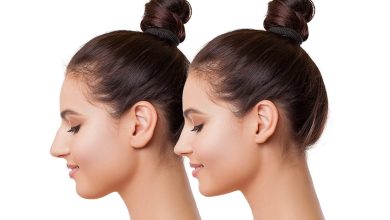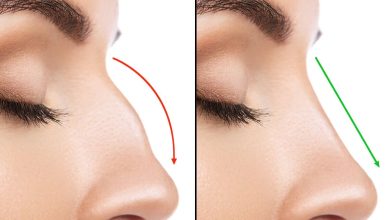Comparison of Open and Closed Techniques in Rhinoplasty
In Rhinoplasty, two techniques known as open and closed techniques are commonly used to access the bone and cartilage structures beneath the nasal skin. In the surgical technique known as “closed technique” or “closed rhinoplasty”, all of the incisions made on the mucous layer that lines the inside of the nose remain inside the nose, so they are not seen from the outside.
In this technique, the nasal skin is not completely lifted, instead, only the relationship of the nasal skin with the structures under it is eliminated, so that the surgical procedure can be performed through the created opening.
In the “open technique” known as “open rhinoplasty”, an incision is made on the skin of the column between both nostrils called the columella, in addition to the incisions made inside the nose, and then the nose skin is completely lifted towards the forehead. As a result, the bone and cartilage structures to be processed become more visible and accessible.
The closed technique was more commonly used in the early years of rhinoplasty operations in our country, as it was in other countries. The approach to rhinoplasty surgeries and the techniques used have improved over time, with the objective of achieving better and more predictable results. Some surgical procedures that had never been used before became a topic of conversation.
Surgical procedures such as reshaping the tip of the nose with the open technique and placing additional cartilages into the nose began to be more effective over time. With the introduction of the open technique, the error margins of surgeons who have just started performing rhinoplasty have been further reduced. Even slight details that could not be corrected with the closed technique became correctable with the open technique, resulting in more excellent aesthetic results. However, I must underline that both techniques used require extensive training and experience. The surgical technique alone does not guarantee a successful result.
Both surgical techniques used in rhinoplasty (nose job) have advantages and disadvantages of their own
Advantages of the Closed Technique:
- The procedure usually takes less time.
- It causes less postoperative edema at the tip of the nose
- It allows for a quicker return to normal life after surgery.
- There is no risk of scarring on the columella skin between the two nostrils.
Disadvantages of the Closed Rhinoplasty Technique:
- It is necessary to reshape the bone and cartilage structures through a limited area.
- The cartilages of the nasal tip, in particular, are more difficult to reshape. Since the suture techniques intended to reshape the nasal cartilages and provide symmetry cannot be used effectively, cartilage grafts are used more commonly.
- Making the desired changes in the nose and getting satisfactory results requires a lot more expertise.
Advantages of the Open Technique:
- The structures of the bone and cartilage that will be changed are easier to assess. Asymmetries and slight deformities that are unnoticeable from the outside are easier to reveal.
- Both hands and eyes are more effectively used.
- Bleeding management is easier and more effective.
- Instruments such as ultrasonic piezo are more easily used.
- In particular, it is easier and more predictable to intervene in the cartilage structures that constitute the nasal tip and to give the desired shape and symmetry to these structures with suturing techniques. It is easier to use cartilage grafts intended to support the nasal tip region.
- A wide variety of techniques can be used more easily in revision (secondary) rhinoplasty.
- It allows different tissues, such as cartilage, bone, or fascia, to be placed in their ideal locations and fixed there with the help of sutures.
- The open technique usually produces more manageable and predictable results than the closed technique.
Disadvantages of the Open Technique:
- The surgical procedure takes longer
- It causes more postoperative edema at the tip of the nose and makes recovery time longer.
- The incision made on the skin of the columella may leave a scar, and circulatory disorder may develop there.
In conclusion, my personal comment on these techniques is as follows:
- These techniques used in surgical procedures do not guarantee a successful result on their own; so both techniques have the potential to produce successful or unsuccessful results. The most important thing in this regard is the surgeon’s experience in, and command of, the technique to be used.
- The technique to be used can also be chosen based on the type and extent of the nasal deformity. The closed technique may suffice in cases where the tip of the nose does not require much change, while the open technique is more effective in cases where the tip of the nose also needs to be reshaped to a considerable extent or where revision is required.
- I can say that plastic surgeons who perform rhinoplasty procedures prefer the open technique to achieve more manageable and predictable results.
- In my practice, I mostly use the open rhinoplasty technique. For information on the characteristics of a candidate suitable for rhinoplasty, the dos and don’ts before and after surgery, and the answers to the frequently asked questions about rhinoplasty, you can visit our page.





